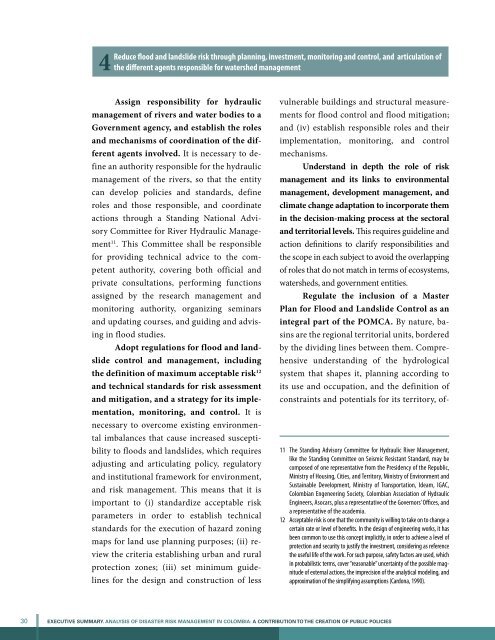Executive Summary - GFDRR
Executive Summary - GFDRR
Executive Summary - GFDRR
You also want an ePaper? Increase the reach of your titles
YUMPU automatically turns print PDFs into web optimized ePapers that Google loves.
4<br />
Reduce flood and landslide risk through planning, investment, monitoring and control, and articulation of<br />
the different agents responsible for watershed management<br />
Assign responsibility for hydraulic<br />
management of rivers and water bodies to a<br />
Government agency, and establish the roles<br />
and mechanisms of coordination of the different<br />
agents involved. It is necessary to define<br />
an authority responsible for the hydraulic<br />
management of the rivers, so that the entity<br />
can develop policies and standards, define<br />
roles and those responsible, and coordinate<br />
actions through a Standing National Advisory<br />
Committee for River Hydraulic Management<br />
11 . This Committee shall be responsible<br />
for providing technical advice to the competent<br />
authority, covering both official and<br />
private consultations, performing functions<br />
assigned by the research management and<br />
monitoring authority, organizing seminars<br />
and updating courses, and guiding and advising<br />
in flood studies.<br />
Adopt regulations for flood and landslide<br />
control and management, including<br />
the definition of maximum acceptable risk 12<br />
and technical standards for risk assessment<br />
and mitigation, and a strategy for its implementation,<br />
monitoring, and control. It is<br />
necessary to overcome existing environmental<br />
imbalances that cause increased susceptibility<br />
to floods and landslides, which requires<br />
adjusting and articulating policy, regulatory<br />
and institutional framework for environment,<br />
and risk management. This means that it is<br />
important to (i) standardize acceptable risk<br />
parameters in order to establish technical<br />
standards for the execution of hazard zoning<br />
maps for land use planning purposes; (ii) review<br />
the criteria establishing urban and rural<br />
protection zones; (iii) set minimum guidelines<br />
for the design and construction of less<br />
vulnerable buildings and structural measurements<br />
for flood control and flood mitigation;<br />
and (iv) establish responsible roles and their<br />
implementation, monitoring, and control<br />
mechanisms.<br />
Understand in depth the role of risk<br />
management and its links to environmental<br />
management, development management, and<br />
climate change adaptation to incorporate them<br />
in the decision-making process at the sectoral<br />
and territorial levels. This requires guideline and<br />
action definitions to clarify responsibilities and<br />
the scope in each subject to avoid the overlapping<br />
of roles that do not match in terms of ecosystems,<br />
watersheds, and government entities.<br />
Regulate the inclusion of a Master<br />
Plan for Flood and Landslide Control as an<br />
integral part of the POMCA. By nature, basins<br />
are the regional territorial units, bordered<br />
by the dividing lines between them. Comprehensive<br />
understanding of the hydrological<br />
system that shapes it, planning according to<br />
its use and occupation, and the definition of<br />
constraints and potentials for its territory, of-<br />
11 The Standing Advisory Committee for Hydraulic River Management,<br />
like the Standing Committee on Seismic Resistant Standard, may be<br />
composed of one representative from the Presidency of the Republic,<br />
Ministry of Housing, Cities, and Territory, Ministry of Environment and<br />
Sustainable Development, Ministry of Transportation, Ideam, IGAC,<br />
Colombian Engeneering Society, Colombian Association of Hydraulic<br />
Engineers, Asocars, plus a representative of the Governors’ Offices, and<br />
a representative of the academia.<br />
12 Acceptable risk is one that the community is willing to take on to change a<br />
certain rate or level of benefits. In the design of engineering works, it has<br />
been common to use this concept implicitly, in order to achieve a level of<br />
protection and security to justify the investment, considering as reference<br />
the useful life of the work. For such purpose, safety factors are used, which<br />
in probabilistic terms, cover “reasonable” uncertainty of the possible magnitude<br />
of external actions, the imprecision of the analytical modeling, and<br />
approximation of the simplifying assumptions (Cardona, 1990).<br />
30 EXECUTIVE SUMMARY. ANALYSIS OF DISASTER RISK MANAGEMENT IN COLOMBIA: A contribution TO the creation of public policies

















